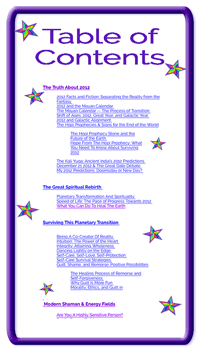Dream Analysis in Dream Work

|
|
|
|
|
Interpreting The Dream
This is what dream analysis is all about. You take the dream, break it down, and look at it piece by piece.Each bit of your dream has a message for you.
The subconscious doesn't waste any bandwidth! It will layer meaning within meaning, for you to discover . . . whenever you choose to know yourself and the Divine this intimately. So in dream analysis, every little symbol, every person, even the setting tells you something. Now let's look closely at what your dream is trying to tell you.Dream Symbols
This is the meat of the dream analysis. Here's where you begin to uncover the vocabulary that the Divine or your Higher Self uses to connect with you. Symbols are the "words" that the Divine uses to communicate with you. Very few people "receive" verbal linguistic communication from the Divine. Rarely does anyone actually hear "turn left at the next corner" from their guides, angels, or god/desses. But even when they do, this is using symbolism. Words are just symbols for things and ideas. In the same way, dream analysis looks at the symbols as words in a letter. Symbols are the vocabulary the Divine uses to communicate. When you understand this, you can begin to comprehend the real power of dream work. Over time, you can master this dialogue with Divinity. You been to notice how She communicates with you in the waking world, just as in your dreams. Opening this channel of communication is one of the greatest benefits of dream analysis. Especially for Wiccans, whose spiritual path is one of co-creating life with the Divine. So in this dream work method, we'll break the symbols down into categories.
There's Only One Real Dream Dictionary
But first, a word about dream dictionaries. Let me clarify right away that there's no such thing as a generic one-size-fits-all "dream dictionary." It's not possible. Dreams speak in symbols, as we've seen. The thing is, everyone's symbols are unique. Your dreams will speak with a vocabulary of symbolism that relates to your personal experiences in life. Generic dream dictionaries are based on the fact that many people in a culture share certain symbolisms. For most Westerners, a car - for instance - signifies the "vehicle" in which you travel through your life. That is, your body, your life, or your experiences. For many people, many of these symbols will resonate. So I don't mean to suggest that a dream dictionary is a waste of paper. For many people, a good dream dictionary can help clarify confusing dream symbols. Yet for some people, some of the common interpretations won't fit at all. A young teenager may see a car as freedom, or adulthood, or fearful new challenges to master. Someone who has been seriously hurt in an auto accident would have their own meaning for a car! And there can be a world of difference between the meaning of a car when you are driving, and when it's coming at you on the street. So the only way to proceed is to learn to understand the symbolism in your dreams. As you practice dream analysis, you'll find that you are creating your own, personalized dream dictionary. As well as gaining real insight into your inner being.How to Begin Your Dream Analysis
Read back through your dream. Underline all the major words: the objects, the people, the surroundings, the actions. Write these down in a list, underneath your dream. We call these "keywords." Now, make note of any associations and meanings that arise when you think of each keyword.
The Objects
The best place to start dream analysis is with the objects in your dreams. These are all the nouns you wrote down. For example, if we were doing dream analysis for the dream of the car, we could write:
Then we go back through the list and fill in what each of these objects means to us. For example . . .
- Car
- Dog
- Passenger
- Office
- Ice
Car Vehicle, mobility, freedom, getting where I want to go, capable of achieving my goals, personal power, etc.As this example shows, in dream analysis you use literal associations as well as "free associations," that is, ideas that pop into your head when you think about the object. Repeat this with each of the words.
The Actions
Now go back through your dream and underline all the action words. For example . . .
- Running,
- Looking,
- Hearing,
- Picking up,
- Sitting down, etc.
Getting out: Leaving, abandoning, hightailing it, moving on . . . . Getting out of the car: Standing up, taking action, leaving behind my support to go ahead on my own . . .
The Settings
Use the same process with the settings in your dreams. The settings are the landscapes in your mind. You may not have thought of the surroundings when you first wrote the dream down, so you can go back now and ask yourself, Where was this happening? In our sample dream, I was driving across ice, like a frozen lake or maybe ocean. The office was on the ice as well. Now ask yourself, What does this location mean to me? In our sample dream, you might come up with associations like . . .
On the ice of a frozen ocean: Standing on water, walking on water, walking on thin ice, frozen emotions, deep unknowns perhaps lurking underneath, cold, chilled, like death, quiet passive death (freezing and drowning are) . . . .You can see in this example how one association sparked another . . . "standing on water" made me think of "walking on water." Go with these insights! They can be invaluable to the dream analysis process.
The People
When you look at the people in your dreams, you really begin to see some of the levels of meaning that your dreams offer you. Start with the most basic. If you dreamt of your brother Bob, write down what qualities you associate with Bob.
Bob: Pushy, obnoxious, selfish, self-absorbed, caring, tries to help people in a heavy-handed way, good with tools, mechanic, eldest, . . . .This will help you identify the characteristics that are being pointed out in your dream.
Are You Dreaming Of Others, Or Yourself?
We commonly feel that when we dream of another person, the dream is actually about them. This may or may not be true. If you dreamt of Bob getting a divorce, maybe it's signaling a problem in his marriage. But even if this is so, the dream is saying more than just that. You may have heard it said that everyone in your dreams is you. And it's true. There is an aspect of you that is like Bob. If this weren't so, he wouldn't show up in your dreams! We don't often enjoy seeing ourselves in a negative way. It's easier for our subconscious to say that we have some Bob-like characteristics, by showing us an image of Bob, than to say to ourselves that we're being selfish or whatever. This also happens in a positive way. If you dream of Mother Teresa, there is a part of you that demonstrates some of her positive characteristics too. We all have both sides of the coin, the pure and the distorted qualities within us. So when you dream of Bob, the message is that there's a Bob-like personality aspect that's coming up in you. For more clues, you can look to your relationship with the person. If Bob is your brother, then explore what "brother" may mean to you. It may be quite different from the meaning of sister, father, friend, stranger, etc.The "I"
This is a surprisingly illuminating part of the process. Start by circling every time the word "I" appears in your dream. We naturally assume that the "I" in the dream is a constant, just as we assume who we are in life is the same "I" from moment to moment and day to day. In dreams, though, it sometimes becomes obvious that there are multiple "I"s, levels of "I"s. Have you ever had a dream where at first you were watching somebody, and then later you were that person, experiencing the action from their viewpoint? Or have you ever dreamt that you were watching yourself as you participated in the dream, as if from an outside perspective? There can be many "I"s in every dream. Explore each "I" as if it were a unique individual.
- Which "I" was in the car, traveling across the ice?
- Which "I" got out?
- What part of you is the Do-er, of each action?
- What part of you is the Observer?
- Is there an observer of the Observer?
Taking Dream Analysis Deeper
For all the depth you've uncovered so far, this is still just the surface level of dream analysis. You can mine your dream for more information, in each of these steps, by asking yourself deeper questions about these symbols. In the setting, for instance, we could ask:- What else was around?
- Could I see a shoreline?
- What was the weather like?
- Was it day or night?
- Was I feeling cold, or warm, or what?
Dialoguing With The Dream Symbols
A very illuminating practice is to dialogue with the people or other symbols in your dream. You can communicate with them through writing. For instance, if you dream of a bird, you could then dialogue with it (as described in the linked article). This way, it can often tell you what you need to know. This is even useful for inanimate objects, like a ring or something that seems important to you.(It's also a great way to determine what messages are being sent to you by creatures in the waking world. For instance, if you have an encounter with a butterfly or skunk or eagle or whatever, you can dialogue with it in this fashion and discover what meaning it has for you, and what the creature (or the Divine) is trying to tell you.)
Analyzing Your Dream Analysis
You can ask yourself questions about the symbols within the symbols. For example, one of the associations for car was "mobility." Perhaps when you wrote that, you felt a pull toward that word. So you could investigate more by calling forth the associations you have with the word "mobility." You can perhaps begin to imagine how even the most minute scrap of a dream fragment can yield an incredible amount of information through dream analysis. Swami Radha has said that you could continue to explore one dream for the rest of your life, and always gain new insights. The meanings that come through will be just as valid 20 years from now, as today's meanings are. Even though your dream analysis may then be completely different. Now, for the next step in dream analysis, see the following article on Dream Interpretation.With Brightest Blessings,
erin Dragonsong

Return from
Dream Analysis
to
Wicca Practices










